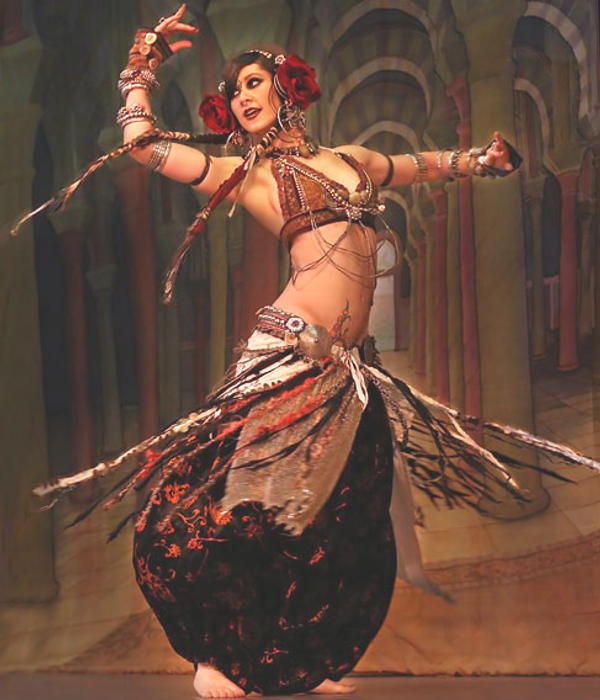History of belly dance: Oriental dance is one of the oldest dances in the world, combining elements from different countries in the Middle East and North Africa, although its precise origins are uncertain.
In Arab countries this dance is called Raks Sharki Oriental Dance meaning literally.
The name belly dance began to be used in the nineteenth century by Europeans who traveled to exotic lands in search of new cultures, customs and scenery. These travelers gave this term surprised by the belly and hip movements that did not exist in European dances.
We have to distinguish between the Raks Sharki (Oriental dance) and Raks Baladi (Dance of the People). Raks Baladi The most basic is a dance, movement and virtually no hip movement predominate. The Raks Sharki is more refined and rich. Includes movements of Egyptian folklore, ballet and contemporary dance, with large movements, turns and moves to all parts of the body, although the hip are also the most important.
In some ancient people thought that human fertility was directly related to the earth.
Women, who were they created new lives, they attributed magical powers. For example: In the Central Anatolya and Mediterranean (Turkey), for thousands of years, women were ritual dances in honor of these magical powers (ceremonies related to fertility). The men were excluded from these rituals. In ancient Greece and Rome were performed different dances of fertility based on the rotation of the hips and belly.
Some of them were held in honor of the goddesses. Many of these gods came from the East, particularly Syria and Turkey.
In Cyprus, birthplace of Aphrodite, the Greek goddess of love and fertility, women performing erotic ritual dances accompanied by songs and percussion through which they put in a trance.
This allowed them to come into contact with the goddess and it will pass his power. Also, these rites or the like took place in Mesopotamia, Phoenicia, Egypt, Arabia and India. In these ceremonies involving large numbers of women. They danced, sang and even some women were offered to men in honor of the goddess. The purpose of these ceremonies was to bring the power of the earth goddess and promote fertility.
During the fourth century D. C. Christianity and Islam came to dominate the Middle East. While taking certain pagan rites and festivals and they are appropriated adapting to his new religion, also destroyed the ritual worship of goddesses and tried to eliminate female dances related to sexuality and fertility. Centuries ago, dancers, musicians and singers were slaves. Although this status then changed the interpreter never fully escaped the stigma attached to their profession within countries árabes.Durante the nineteenth century, in Egypt there were two types of dancers: the ghawazee (Gypsy) who danced in the open or in the field, usually for lower-class audiences. They acted with a small group of musicians who used to include mizmar, nay and table. The awalim were most respected and well danced, sang and recited poetry. Normally operating in rich houses. Musical instruments were: nay, oud, kanoon board. In both cases, the dance was improvised. Until 1930, the dancers had acted primarily in people's homes or in cafes. That year, in Cairo, a Lebanese woman named Badia Mansabni opened a nightclub called Casino Badia.
This room became very popular. He had a diverse program that was based in the east and offered dancers, singers, musicians, comedians and European numbers. Oriental dance is always danced in small spaces. In the Casino Badia had to be adapted to large scenarios. Mansabny Badia also to train their dancers worked with choreographers and dancers Europeans to include elements of other dances (ballet). These dancers usually acting in groups, although they were noted for their talents were sometimes a single. During this period it became fashionable two-piece suit with rhinestones and fringes that was inspired by American films. In those years there were a lot of movies in Egypt and was common to include a scene of dance or have a dancer as the protagonist. Many scouts went to the Casino Badia dancers looking for these scenes. The dancers were very successful actresses in the audience. Many of these dancers discovered in the Casino Badia became very popular movie stars and acquired a status that never had before. Currently, Oriental dance in most Arab countries is part of the culture and a celebration without a belly dance show is not complete.
Virtually all Arab women Raks Baladi dance, learn from girls at parties and family gatherings, but few who dare to be professional, because being a dancer is not well seen in a traditional Muslim society.
BellyDance.org - Belly Dance DVDs, History, Photos, Events and More!
the Bellydance MuseumCopy right history of belly dance

0 comentarios:
Publicar un comentario